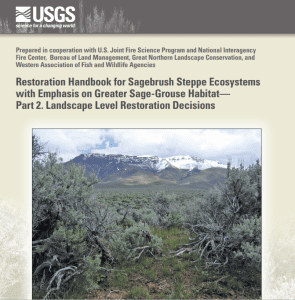Restoration
View article.
In this Live Science article, Francis Kilkenny, lead of Great Basin Native Plant Project (GBNPP), shares information about the GBNPP and how it continues to support more successful rangeland restoration.
Lessons learned, so far include:
- Climate is more important than geography when predicting how well seeds will grow and establish themselves. Seeds don’t care where their parents lived if the temperature suits them and if they get the right amount of sunshine and precipitation.
- Timing of seed planting makes a big difference. Year to year, even week to week, variation in weather patterns can affect the restoration success of a burned site.
- Method of planting matters. To achieve the best results, scientists recommend tamping seeds into the ground to ensure they have good contact with the soil, or in some cases, planting a species in the form of “plugs.”
- Long-term monitoring after planting is critical to determine the effectiveness of different seed mixes and restoration techniques.
- Keeping livestock off seeded rangeland for at least three years improves a restoration effort’s likelihood of success.
View handbook.
This handbook is intended to assist decision makers in determining landscape objectives, to identify and prioritize landscape areas where sites for priority restoration projects might be located, and to aid in ultimately selecting restoration sites guided by criteria used to define the landscape objectives. The landscape restoration decision tool is structured in five sections that should be addressed sequentially. Each section has a primary question or statement followed by related questions and statements to assist the user in addressing the primary question or statement.
View bibliography.
This bibliography reflects the growing interest in assisted migration, the intentional movement of plant materials in response to climate change, and provides a central foundation for collaboration in generating research questions, conducting studies, transferring and acquiring data, expanding studies to key species and geographic regions, and guiding native plant transfer in changing climates. It should inform management as the mismatch in rates between climate change and plant migration and adaptation pose significant challenges for natural resource managers, especially when scientific information often lags behind the demand for management actions.
View infographic.
This infographic developed by SageSTEP.org describes sagebrush steppe restoration prioritization and methods to benefit sage-grouse habitat.
View handbook.
This handbook discusses concepts surrounding landscape and restoration ecology of sagebrush ecosystems and greater sage-grouse that habitat managers and restoration practitioners need to know to make informed decisions regarding where and how to restore specific areas, by providing:
- Descriptions of plant dynamics of sagebrush steppe ecosystems and their responses to major disturbances, fire, and defoliation.
- Introductions of the concepts of ecosystem resilience to disturbances and resistance to invasions of annual grasses within sagebrush steppe.
- Introductions to soils and ecological site information will provide insights into the specific plants that can be restored in a location.
- Descriptions of concepts of landscape ecology that aid decisions regarding habitat restoration.
- Overviews of restoration techniques for sage-grouse habitat restoration.
- Descriptions of the critical nature of monitoring for adaptive management of sagebrush steppe restoration at landscape- and project-specific levels.
View research brief.
This study shows that conifer removal for sage-grouse also benefits sagebrush-dependent songbirds. In the Warner Mountains of southern Oregon, Brewer’s sparrow abundance increased by +55% and green-tailed towhee jumped +81% following cuts. Annual increases each year post tree removal suggest that songbird use may increase even more with time. Abundances of species less dependent on shrublands including mountain bluebird and rock wren were unaffected by treatments.
View abstracts.
These abstracts of recent papers on rangeland management in the West were prepared by Charlie Clements, Rangeland Scientist, USDA Agricultural Research Service, Reno, NV.
View article.
This study tested the stress-gradient hypothesis (SGH) in observations of 75 sites along overlapping water and heat stress and disturbance gradients. As stress-disturbance levels increase, sagebrush-herbaceous plant facilitation levels increase, the landscape will become increasingly aggregated as a product of necessary facilitation between sagebrush and herbaceous plants. This aggregation decreases the individual resilience of the native herbaceous plants, increases the competition from invasive plants, and decreases the overall stability and resilience of the sagebrush steppe ecosystem.
View article.
This study found that early seral natives generally outperformed late seral natives when growing with exotics and had earlier emergence timing, although results differed among functional groups and soil types. Survival probabilities, however, did not differ between the early and late seral mixes when growing without exotics. Within each seed mix, native grasses exhibited the highest emergence probabilities of the functional groups. Natives did not suppress exotics in early life stages. Performance of B. tectorum was higher on sandy loam, while T. caput-medusae was highly successful in both soil types. Performance of native functional groups differed by soil type when growing with exotics but did not differ when growing without exotics. Survival of native grasses, in particular, was generally higher on sandy loam when growing with exotics.
View report.
This final report includes actions to be implemented by Interior’s bureaus to immediately address the threat of rangeland fire and other disturbances to Western sagebrush-steppe landscapes and improve fire and fuels management efforts.



